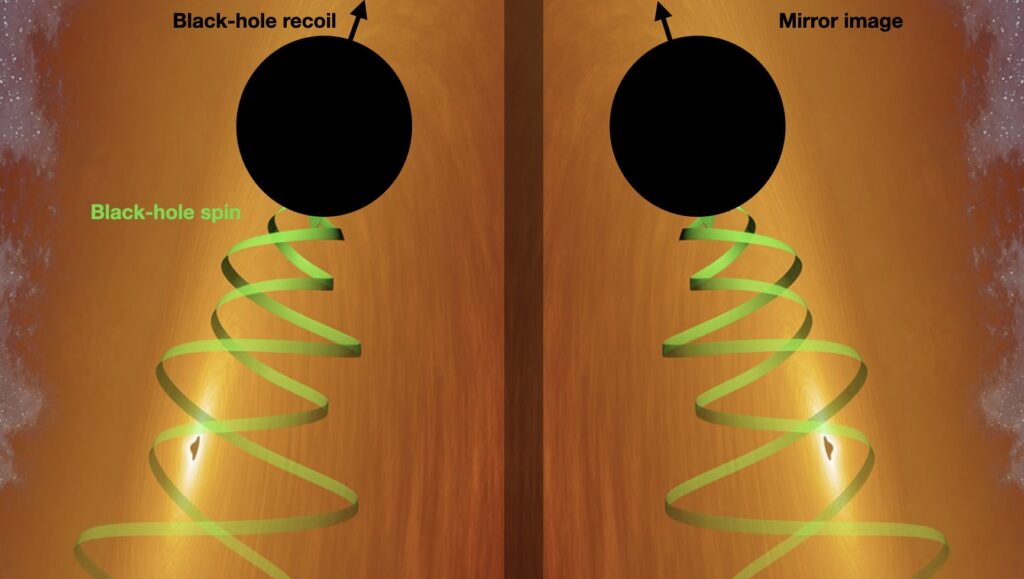In an article published in Physical Review Letters on Thursday, scientists from the Instituto Galego de Física de Altas Enerxías (IGFAE), University Carlos III of Madrid and the University of Valencia carry out an innovative study testing the existence of mirror asymmetries in our Universe by studying the handedness of the gravitational-wave emission from black-hole mergers detected by Advanced LIGO and Virgo.
Testing the Cosmological Principle and gravitational waves
The pillar of modern cosmology – known as the Cosmological Principle – states that, when observed at large scales, the Universe is isotropic and homogeneous. This is, all observers in the Universe will roughly observe the same structures regardless of where they are or where they look at. As a consequence, the Universe must not display a preference for stuff that rotates clock or anti-clockwise but, which is known as “mirror symmetry”.
Einstein’s theory of gravity, known as General Relativity, predicts that massive bodies can produce a type of radiation known as gravitational waves, which consist of distortions of spacetime that travel away from their sources at the speed of light. Such waves are produced in some of the most violent events in the Universe like supernovae, black-hole mergers or the big bang itself. Just like electromagnetic waves, gravitational waves have a property known as polarization, which can be either right- or left- handed. In other words, the wave can somehow ‘rotate’ clock- or anticlockwise to its direction of propagation. Some types of black-hole mergers – particularly those displaying a precessing orbital plane – can indeed produce an excess of one polarization over the other, individually breaking mirror symmetry.

Juan Calderón Bustillo (IGFAE) y Nicolás Sanchis Gual (Universitat de València), dos de los autores del artículo. Foto: IGFAE.
A football analogy
If the Cosmological Principle holds, however, the mentioned excesses should average to zero across all of the sources in the Universe. Juan Calderón Bustillo, lead author of the paper and Ramón y Cajal Researcher at the Instituto Galego de Física de Altas Enerxías (IGFAE), joint centre of the University of Santiago de Compostela and Xunta de Galicia, proposes a simple football analogy. “In football, there are two main ways to kick the ball with either the inner or outer part of the foot. The first will cause the ball to spin anticlockwise (think of David Beckham’s famous freekicks!) while the opposite will induce the opposite spin (think of Modric or the young superstar Lamine Yamal, who masters this move). Most shots, crosses and passes, however, are made with the inner side of the foot, as this makes it considerably easier to control the ball, right? This induces an asymmetry between the two types of spins, making football “mirror asymmetric”. If our standard assumptions about the Universe and gravity hold, this should not happen to the waves emitted by black-hole mergers in the Universe”.
Are black-hole mergers right or left-handed?
In this study, the authors measured the polarization of the waves emitted by 47 black-hole mergers detected by Advanced LIGO and Virgo, finding three main results. First, the results are consistent with a null average polarization across the sources, in compliance with the cosmological principle. Dr. Nicolas Sanchis-Gual, co-author of the study and Ramón y Cajal Researcher at the University of Valencia says, however “the statistics are very limited though, so uncertainties are still large. This cosmic football game is far from over”.
Second, the study did only identify one individual system – known as GW200129 – that conclusively breaks mirror symmetry. However, it also indicates that at least 82% of the studied black-hole mergers must do so, even if these cases can’t be individually pinpointed. Koustav Chandra, co-author and postdoc at Penn State adds “it is kind of natural that GW200129 breaks mirror symmetry, as this system is known to have a precessing orbital plane. However, our result indicates that a lot of mergers also break it, suggesting that these could also have precessing orbital planes. These unexpected results could have far-reaching implications, as precession is a signature of hierarchical formation of black holes”.
Finally, as Dr. Adrian del Rio, co-author and Cesar Nombela researcher at the University Carlos III of Madrid indicates, the results are also of high interest for the area of quantum gravity. “In a previous study, we demonstrated that mirror asymmetric mergers could produce a net emission of polarised photons from the quantum vacuum, through a process similar to Hawking radiation. Our study has identified the first viable source – GW200129 – that can produce this effect”. Dr. del Rio, however, stresses the most interesting point of the study: “Einstein’s equations for gravity, which rules the Universe large-scale behaviour, allow a left- (right-) handed gravitational source per each one of the opposite handedness. These equations, however, do not require the existence of both types of sources with the same proportions in our Universe. Our work allows us to test whether gravity (or our Universe) has “hidden” mechanisms to produce asymmetries.”. Consequently, this new method has a huge potential to help unravel the mystery behind the so-called Hubble Tension.
An unexpected parallelism to particle physics
In a different study released on arXiv this Tuesday, the authors have shown that the analyzed observable is closely related to a very well-known strong-field phenomenon known as gravitational recoil, or kick. Samson Leong, Ph.D student at The Chinese University of Hong Kong and lead of this study explains: “Black-hole mergers emit gravitational-waves in a non-isotropic manner. Just like it happens when you shoot a gun, this causes the final black-hole to acquire a recoil.”. He then adds: “this final black-hole will also have a spin. Just like in the case of soccer balls, this spin can be either right- or left- handed with respect to its direction of motion. In this second study we found that the observable that measures the net polarization of the waves is linearly related to the projection of the kick along the direction of the spin. In other words, we are looking at the helicity of the final black hole!”
The above establishes a fascinating analogy with the experiment that led to the discovery of parity-symmetry breaking by the weak force. In this famous experiment, Prof. Chien-Shiung Wu and colleagues found that the electrons resulting from the beta decay of Cobalt atoms are emitted preferentially “upwards”, along the direction of the Cobalt atom spin, as opposed to being isotropically emitted. “In our case, we are doing something very similar by testing whether black-holes resulting from black-hole mergers recoil preferentially “upwards” or “downwards” with respect to the direction of their spin”, finishes Dr. Calderon Bustillo.
